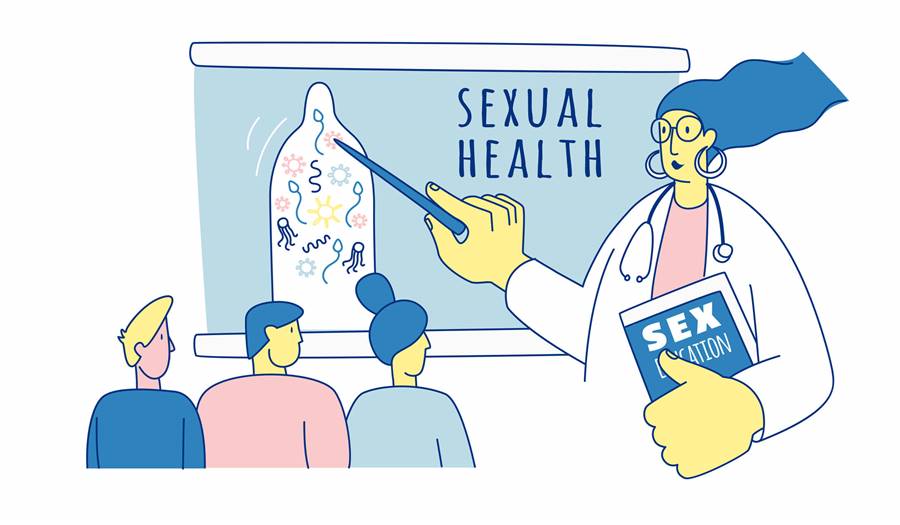
Sex Education - Part 2: Safety & Health
11/29/2021
Last week we learned about the importance of sex education and how to start talking to our kids. This week we are doing to discuss safety and health around sex. We will touch on consent, contraception, sexually transmitted infection, and some negative things that need to be discussed around sex.
THE TALKS, CONTINUED
SEX: HEALTH AND SAFETY
Consent
Consent is a very important topic that should be discussed with all children and the younger you start, the better. Your child should be taught that their body is their body, and they control who, when, and how someone touches their body. We want our children to know about consent and practice consent in interactions BEFORE its even about sex. The more practice they get with non-sexual touches, the more likely they are to stand up for themselves with unwanted sexual touches.
Consent is important to reinforce with teens who are in relationships. Media very rarely depicts the communication and consent that is essential before being intimate. The examples they see do not reflect what they need to do to have safe encounters.
We want our teens to have safe and healthy relationships with communication and consent being cornerstones. Consent is showing your partner respect, care, and safety. It is NOT negotiable. Communication and consent are essential for healthy relationships and to have safe and pleasurable sex. You cannot read minds, nor can anyone read your mind. You must be very clear and specific. There is no room for error.
Consent should be received and given for kissing, touching, hugging as well as sex. Consent is not just NO. Consent needs to be verbal and explicit and affirmative. Consent should happen before any encounter.
Consent is
- A strong affirmative yes
- Explicitly stated
- Not assumed
- Should be given by both partners
- NOT a shrug
- NOT silence
- NOT maybe
- CANNOT given if you are drunk or using drugs
- CANNOT given if you are threatened or scared for your safety
- CANNOT given if you are coerced
- IS NOT based on past sexual experiences with your partner
- IS NOT based on past sexual experiences with other partners
- IS NOT permanent or unchanging, you can change your mind at any time
- IS NOT promised just because you said yes before
- IS NOT based on clothing, make up, dancing, or the way you move
- IS NOT a given for everything if you consent to one thing
Becoming Sexually Active
Part of sex education should include discussing how a person should decide to become sexually active. Becoming sexually active is a special and unique experience, the timing of which can only be decided by the people in that relationship. There is a lot to think about before having sex including
- How do you feel about your partner?
- How do they feel about you?
- Are they respectful and kind?
- How will you feel after? Awkward? Closer to that person?
- Can you handle possible consequences of having sex?
- What will you use for contraception and to prevent sexually transmitted infection?
- Has your partner had sex before and should they be tested for sexually transmitted infections?
- What do you consent to and what do they consent to?
- Are there any limits to what activities you want to do?
- Will you be okay asking your partner to stop if you change your mind?
- Do you feel comfortable talking to your partner about what feels good to you or doesn’t feel good to you?
Before having sex, think through all these questions and any possible emotional reactions, both positive and negative, and your what your course of action may be if you feel strong feelings. If the answer is no or negative to any of the questions above, more thought should go into this decision.
Your child should know that their safety is your top priority. This means making sure they can identify that they are ready for the responsibility of pregnancy prevention, disease prevention, and communicating consent and choices.
Before having sex, they should be able to have a conversation with their partner that includes talking about what they consent to, a discussion about safety and anything a person should need to know about health or bodies, a discussion on boundaries, and a discussion on pleasure.
Teens often worry people will be able to tell if they have been sexually active. There is no way to look at a person and tell if they have had sex. Virginity cannot be “seen” on a medical exam and cannot be based on whether the hymen (a tissue in the vagina) is intact. Some people are born without a hymen, but most girls may have broken their hymen biking, horseback riding, or using a tampon before they become sexually active.
CONTRACEPTION
Contraception is pregnancy prevention. There are different medications or devices that can help prevent pregnancy. The only method that is 100% effective is abstinence. Other methods, discussed below, have varying degrees of effectiveness. There are also risks, benefits, and potential side effects with these methods. Each individual needs to determine which method is the best method for their body and their relationship.
If your child is thinking of becoming sexually active, it is imperative they have a plan for contraception. There are effective and affordable contraception methods available. Your child should know what is available and where to get contraception. Providing this type of education and making sure they know you are a resource they can trust, makes teens more likely to seek out and use contraceptive methods when they become sexually active.
Barrier Methods
Barrier methods include internal and external devices.
Condoms are an external barrier device made of latex, synthetic or natural material to prevent pregnancy. A condom covers the penis during intercourse to prevent semen from entering the vagina. These are widely available at health stores, clinics, and online. They are affordable but can be found for free at many health clinics. There is no age limit for purchasing condoms.
It is helpful to demonstrate correct condom use before one is needed. Both males and females should be familiar with how to correctly use a condom. Before using a condom, the expiration date should be checked. They do expire! When opening the package, do not use teeth or a sharp object as it may damage the condom. When taken out it should look like a hat. The material should not be cracked or have any holes or rips.
To put on the condom, hold the tip to remove air and roll the condom down the penis. It should roll easily. If it does not roll easily, discard and use a new condom. Most condoms come with a built-in lubricant but if it does not ONLY water-based lubricants can be used. Oil based lubricants or Vaseline will break down the condom and make it ineffective. After intercourse, the bottom of the condom should be held onto the penis as the penis is removed from the vagina. The condom should then be removed by pulling it off the penis, tied at the top, and then discarded. A condom is only used once and only one should be worn at a time. Two is not better or safer!
Dental dams are the other most common type of external barrier device available. A dental dam is a latex sheet that provides a barrier. The barrier is placed over the penis, vagina, vulva, mouth, or anus. When placed on the penis or vagina, it prevents semen from entering the vagina.
An internal barrier device would be a diaphragm or cervical cap. A diaphragm or cap is a device inserted into the vagina that covers the cervix to prevent sperm from passing into the uterus. It is used with a gel that kills sperm called spermicide. It must be fitted by a medical provider to make sure it is the right size for you. It is placed before intercourse and left in the vagina for 6-8 hours after intercourse. Learning to correctly insert and place a diaphragm can be tricky. This form of contraception is very rarely used for teens or young adults.
Barrier methods are 78-99% effective if used correctly. They do not have any side effects.
Hormonal Contraception
Hormonal contraception is when we use hormones to stop ovulation and pregnancy in a person who has a uterus and ovaries. Hormonal methods include the pill, the ring, the patch or Depo, the injectable form. The “pill” is a daily dose of hormones that must be taken at the same exact time every day. The patch is applied to the body weekly and slowly releases hormones into the body. The ring is a small flexible silicone ring that is inserted every month. It sits in the vagina, around the cervix, and slowly releases hormones. The Depo shot is given every 12-13 weeks. All of these are prescribed by a medical provider.
Hormonal based contraception can have a combination of hormones (estrogen and progesterone) or have just progesterone. Combination hormonal methods come with increased risk of blood clots and should not be taken by people with a family history of clotting disorders or who suffer migraines with aura. Side effects are generally mild, including nausea, headache, breast tenderness and bloating. These side effects improve after the first month or 2 of taking the medication.
Progesterone based contraception is safe for people who have a family history of clotting disorders or migraines with aura. They have minimal side effects. This hormonal method differs from combination-based pills because there is no placebo week in which a person will menstruate. When using progesterone-based contraception it is common to not menstruate, but some people experience spotting. The Depo shot is progesterone-based. It comes with the added side effect of decreasing bone density and is more likely to result in weight gain.
Hormonal contraception is 93-99% effective. Making sure it is taken at the appropriate time or on the correct schedule is important to its effectiveness. These methods, particularly the patch, may also not be as effective on obese patients.
Long-Acting Reversible Contraception
Long-Acting Reversible Contraception (LARC) devices include Intrauterine devices (IUDs) and Implants. These devices are implanted into a the body by a gynecologist but can be removed at any time.
IUDS are T shape devices that can be plastic, copper, or hormonal. They are inserted into the uterus. The plastic or copper ones prevent implantation in the uterus and may prevent sperm from reaching the fallopian tubes. IUDs that release hormones also prevent ovulation and thicken cervical mucus. This makes it harder for sperm to get into the uterus. IUDs can be left in place for 3-12 years.
IUDs are a popular method with teens and young adults. It is a highly effective method of contraceptive, preventing 99% of pregnancies. It also doesn’t require a person to remember to take it daily and it can be left in for years.
IUDs can cause cramping and spotting in the first few months. This should improve over time.
Implant contraception is when a small flexible rod is implanted into the skin of the upper arm. It is about the size of a matchstick. It releases progesterone slowly into the body. This prevents ovulation. Implants last 2-3 years. It is 99% effective at preventing pregnancy. This is also becoming a more popular option with teens and young adults who like the ease and effectiveness of this method. This method had side effects similar to the progesterone based contraceptive pills.
Withdrawal
Withdrawal, or the pullout method, is when the penis is removed before ejaculation. This is a very risky method and is the least effective type of contraception. There is a lot of error with this method. It requires self-control which many teens and young adults may not have. It also ignores the fact that fluids released from the penis during intercourse, but before ejaculation, may have small amounts of sperm in them.
Abstinence
Abstinence is abstaining from sexual intercourse. You can choose to abstain from sex even if you have had sex in the past. It is the only 100% effective contraceptive method. For some people abstinence means not having any type of sex. For others it only includes certain types of sex. As a contraceptive method, it only needs to include vaginal sex.
SEXUALLY TRANSMITTED INFECTION
Sexually transmitted infections (STIs) are diseases that are transmitted via sexual activity. This includes oral sex, anal sex, vaginal sex, and genital to genital contact. STIs are very common. Over 50% of all STIs occur in young adults under the age of 24. STIs include Gonorrhea, Chlamydia, Human Papilloma Virus (HPV or genital warts), Herpes, Syphilis, and Human Immunodeficiency Virus (HIV).
The only way to prevent STIs is by using external condoms or being abstinent. Hormonal contraception, LARCs, internal condoms, and the withdrawal method DO NOT prevent STI.
Some STIs will give you symptoms. Symptoms include genital soreness, genital swelling, rashes, warts, sores, itching, burning or pain, and vaginal or penile discharge. However, you do not always have symptoms with STIs therefore you should have regular screening when you are sexually active. You should also be screened before becoming intimate with a new partner.
Testing can be done at your primary care provider, a gynecologist, or at clinics such as Health Quarters and Planned Parenthood. Tests are either saliva, skin or discharge swabs, a urine test, or a blood test.
Some STIs are treatable while others will be present for life. Some can be very dangerous if left untreated. They can damage reproductive organs, other organ systems in your body, and result in infertility, illness, or death.
If the STI is treatable, medication will be prescribed and sometimes a follow up test will be done. If your STI is not treatable, your symptoms will be treated, and you will be referred to the appropriate provider to follow your infection. If you receive a positive result, you must alert all past partners so they can be treated.
Uprotected Sexual Intercourse
Unprotected sex may result in an STI and/or pregnancy. Unprotected sex may be the results of not being prepared, failure of the contraceptive method, sexual assault, or drug or alcohol use.
If you have unprotected sex, there are options to reduce the chance of becoming pregnant. One option is emergency contraception otherwise known as the morning-after pill. This medication is a single, but high, dose of hormonal contraception that can be taken up to 5 days after intercourse. The earlier you take it the better and before 72 hours is recommended. It can be purchased in a drug store or found in clinics. It is sold under the name PlanB or Ella. This medication works by delaying ovulation. If you are already pregnant it will NOT interrupt the pregnancy. It may help prevent pregnancy, but it does not prevent 100% of pregnancies after unprotected sex.
Inserting an IUD is another way to prevent pregnancy after unprotected sex. This must be inserted by a gynecological provider in an office or health clinic. This can be limiting since it must be done quickly, and unprotected sex doesn’t always happen at convenient times to get an appointment. IUDs are immediately effective if implantation has not occurred.
You can also get an STI from unprotected sex. After unprotected sex you should be tested for STIs. You may also be able to take Post-Exposure Prophylaxis (PEP). PEP is medication taken if you are exposed or may be exposed to HIV. It should be taken within 72 hours of the unprotected sex. You can receive a prescription for PEP at a clinic, a gynecologist, or the emergency room
Urinary Tract Infections
Sexual activity can also result in urinary tract infections in women due to bacteria being pushed into the urethra. Urinating after having sex helps to clean bacteria out of the urethra. This will help prevent urinary tract infections.
SEX EDUCATION: PORNOGRAPHY, SEXTING, AND ASSAULT
Sex education should be positive but also needs to include information about some negative aspects about sex including pornography, sexting, and sexual assault.
Pornography
Discussing sex with your child should include a discussion about pornography. The internet has made pornography readily available to our children. The average age of a child being exposed to pornography online is 11!!! Exposure may be accidental while other exposures are purposeful.
Children should know it is natural to be curious and to want to see what sex is about and what it looks like, but pornography doesn’t represent accurate depictions of sex. It is important to let your child know that pornography should not be used for sex education. Pornography is entertainment NOT education. It is fantasy and is not realistic of healthy, intimate, or loving relationships with equal partners. Pornography is misleading. Pornography often shows bodies that are not realistic or bodies that have been enhanced via surgery or special effects. Body parts may be exaggerated and may emphasize that bigger is better. It rarely represents diversity in bodies, body sizes, shapes, skin color, or hair.
Pornography also involves performance that is unrealistic. This includes the duration of the sex that occurs. It also includes incorrect information about orgasm. It often depicts simultaneous orgasms as the norm. Simultaneous orgasms are very uncommon. The sex shown in pornography is often demeaning to women. It depicts women as only being there to provide pleasure for a man. It rarely prioritizes that both partners deserve pleasure. And it ignores that sex can be funny, clumsy, and awkward at times!
Additionally, it doesn’t mention relationships, consent, contraception or STI prevention. It does not involve the communication that is essential for healthy, safe, and fun sex. It may have scary images or sex acts that are frightening.
Pornography may be hard to avoid (although parental filters on phones, computers, and on WIFI routers can help) but discussing porn can make it less alluring and put it in the correct light, as entertainment and fantasy. And remember, the more education you provide, the less likely your child will need to go searching for answers!
Sexting
Sexting is the texting of nude or semi-nude pictures or sexual activities. This can be dangerous and illegal. Images can live forever, even on apps that promise to destroy images. The ability to “screenshot” images can ensure they never disappear. Privacy can NEVER be promised, and these images can easily be shared. It is also illegal. Sexting can be considered child pornography or sexual harassment. Both parties, the person sending the pictures and the person receiving the picture, can be found at fault in these cases.
When your child has access to texting or a phone with a camera, this conversation should be had. The conversation should include the dangerous aspects of the sexting and how they should NEVER take or send a nude photo to anyone. Anyone that asks for a nude picture is not showing them respect or keeping them safe.
Sexual assault
Sexual assault when someone does something sexual in nature without asking permission first. This can include touching breasts, genital or buttocks as well as inserting something into someone’s body. Assault also includes showing someone something sexual in nature without their consent. Sexual assault happens to 1 in 6 children before the age of 18.
Our goal in teaching our children about consent, and how vitally important it is, is to prevent sexual assault and make it easier to identify when assault is happening. We need to start this education when our children are young. Our children should be taught to ask before touching others and expect to be asked before being touched. Children need to know that sexual assault can happen to anyone no matter your sex or gender, and it is NOT their fault. They should always be asked before being touched. If they are sexually assaulted, they need to tell and adult right away.
Education and resources
WEBSITES:
Amaze provides sex education for children and teens through quick videos on a variety of topics.
Sex Positive Families has online resources, classes, and books for parents and children.
Scarleteen has educational information for adolescents.
Sex education can be scary to start and scary to navigate but is important to keep our children healthy and safe. Start early and keep the conversation going! Remember, its talks, not “the talk”.
Children’s Health Care of Newburyport, Massachusetts and Haverhill, Massachusetts is a pediatric healthcare practice providing care for families across the North Shore, Merrimack Valley, southern New Hampshire, and the Seacoast regions. The Children’s Health Care team includes pediatricians and pediatric nurse practitioners who provide comprehensive pediatric health care for children, including newborns, toddlers, school aged children, adolescents, and young adults. Our child-centered and family-focused approach covers preventative and urgent care, immunizations, and specialist referrals. Our services include an on-site pediatric nutritionist, special needs care coordinator, and social workers. We also have walk-in appointments available at all of our locations for acute sick visits. Please visit chcmass.com where you will find information about our pediatric doctors, nurse practitioners, as well as our hours and services.
Disclaimer: this health information is for educational purposes only. You, the reader, assume full responsibility for how you choose to use it.








